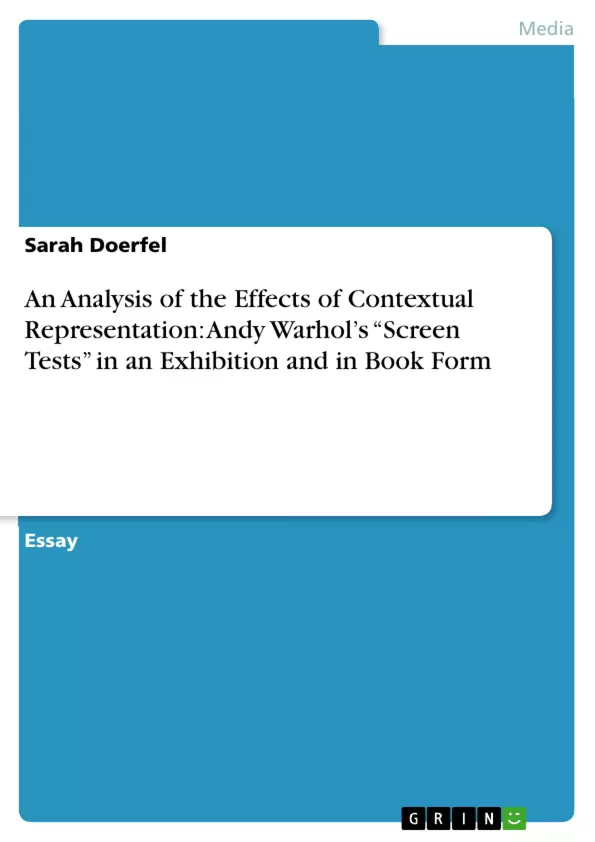In 1964 Pop artist Andy Warhol started to take his “Screen Tests”, short portrait films of his colleagues and friends who visited him in his famous studio, the “Factory” in New York.
Today, more than forty years after the last test was taken, fascination with the films still motivates people to look at them in exhibitions and books. They still catch us with their complex character as time witnesses and social documents, combined with a strong effect as extraordinarily personal pieces of art.
In the following essay, I will illustrate in which way these complex films and their meanings are shaped in different contexts of representation: installed in an exhibition and printed in book form.
At first when dealing with this question, it needs to be clear what the Screen Tests are: The films are not screen tests in the conventional sense of the word. The term usually means short test films taken of actors on castings to decide if they get a part in a film. In Warhol’s Screen Tests, the sitter was instructed to look straight into the camera, without movement or emoting, and if possible even without blinking over the three minutes of recording time. People were recorded in close- ups, deprived of the chance to hide even the smallest movement of their faces (Angell, 2006).
The “Stillies”, as Warhol called them in the beginning, were often produced spontaneously and with casual rapidity. The conceptual sophistication of these films as a whole makes this long- term project a central piece of Warhol’s work as a portrait artist in the medium of both film and painting. They can be seen as the “stem cells of Warhol’s portraiture” (Angell, 2006, p.12): Giving us an overview over the world of fame and glamour in the 1960s scene, with almost exclusively well- known sitters, they deal with the same objects – celebrities – as Warhol’s paintings do.
Like all of Warhol’s early films, they are taken on his first film camera “Bolex” in black- and- white and on silent speed (16 instead of 24 frames per second). It is especially the combination of the slow silent speed, the almost- stillness of the obedient sitters and the unusual lack of sound in the films, which makes these portraits “hybrid art images” (Sokolowski, 2004, p. 9), on the borderline between still photography and the moving image.
Inhaltsverzeichnis (Table of Contents)
- An Analysis of the Effects of Contextual Representation: Andy Warhol's “Screen Tests” in an Exhibition and in Book Form
- Introduction: The Screen Tests and their Context
- The Screen Tests in the Exhibition Setting
- The Screen Tests in Book Form
Zielsetzung und Themenschwerpunkte (Objectives and Key Themes)
This essay explores how the meanings of Andy Warhol's "Screen Tests" are shaped by different contexts of representation. Specifically, it examines the differences between the installation of "Screen Tests" in an exhibition setting and their reproduction in book form. The essay aims to understand how the meaning of these films is influenced by the physical and visual environment in which they are presented.
- The nature and significance of Andy Warhol's "Screen Tests" as a form of portraiture
- The influence of exhibition design on the interpretation of "Screen Tests"
- The impact of the physical and visual characteristics of books on the understanding of "Screen Tests"
- The relationship between the viewer, the "Screen Tests", and the artist's intent
- The power dynamics between the artist, the subject, and the audience in the context of "Screen Tests"
Zusammenfassung der Kapitel (Chapter Summaries)
The essay begins by introducing the "Screen Tests" as a unique form of portraiture, emphasizing their unconventional approach to the genre. The text then focuses on the exhibition setting of "Screen Tests", examining how the installation design influences the viewer's experience and interpretation of the films. It analyzes the size, placement, and arrangement of the screens, and how these elements contribute to a specific viewing experience. The essay also highlights the power dynamics at play, where the viewer occupies a position analogous to the artist's, observing the subjects in a similar way to Warhol himself.
Schlüsselwörter (Keywords)
The essay focuses on key concepts such as contextual representation, artistic intent, audience interpretation, power dynamics, exhibition design, book form, and the nature and significance of Andy Warhol's "Screen Tests" as a form of portraiture. The study considers the influence of both physical and visual environments on the understanding and reception of these films.
- Citation du texte
- Sarah Doerfel (Auteur), 2011, An Analysis of the Effects of Contextual Representation: Andy Warhol’s “Screen Tests” in an Exhibition and in Book Form, Munich, GRIN Verlag, https://www.grin.com/document/208188



